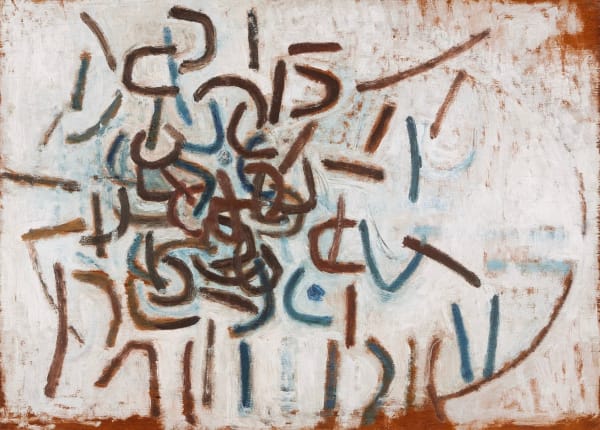Wendy Pasmore 1913-2015
Wendy Pasmore was a Postwar and Contemporary painter. Born in Dublin, Wendy (née Blood) and her family moved to England while she was still a child. In 1933, aged eighteen, Wendy convinced her father, an Army officer, to allow her to attend art school in Chelmsford, before moving to London in pursuit of her artistic career. It was there that she met, and modelled for, a fellow artist, Victor Pasmore (1908-1998). The two were married in 1940 as Victor’s career was beginning to flourish; he had been elected to the London Artist’s Association and the London Group in the early ‘30s, had founded the Euston Road School in 1938, and would go on to become a key figure of the European art world in the mid-century.
Wendy and Victor were at the heart of London’s art scene. Their first home together was on Chiswick Mall, though they are most associated with an imposing house in Blackheath where they settled in 1948, a property still in the family today. Throughout the 1940s and early ‘50s Wendy continued to paint, but with Victor’s prospering career and two young children to care for, as well as her teaching roles, her own painting had become increasingly intermittent.
In 1955, there was a shift in her career and Wendy was elected a Member of the Women’s International Art Club, a society that aimed to help women artists by arranging dedicated exhibitions of their work in prominent galleries, with Sonia Delaunay, Elisabeth Frink, Gwen John and Lee Krasner among its members. Wendy first exhibited her abstract work with the London Group the following year and became a Member in 1958.
Having held teaching posts at a number of art colleges, including Sunderland and Scarborough, Wendy settled at Leeds, where she worked with Terry Frost and others to establish the foundation course that later grew into the Leeds College of Art. With interest in her work growing, in 1963, a retrospective was held for Wendy at the London galleries of Molton and Lords and she was thereafter regularly included in Summer Exhibitions at the Royal Academy.
Aside from London, the Pasmores had a strong connection with Malta, falling for the country after a visit following the 1965 Venice Biennale. The two had acquired a 17th-century farmhouse near Gudja, named Dar Gamri, and settled in to island life with a house full of animals. In 2014, the capital city, Valletta, became home to the Victor Pasmore Gallery, a project that had long been pursued by Wendy and the Pasmore Foundation.




